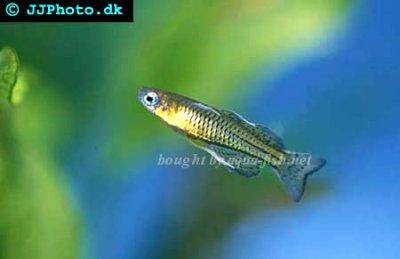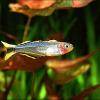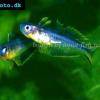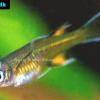Spotted blue-eye - Pseudomugil gertrudae
Scientific name: Pseudomugil gertrudae
Common name: Spotted blue-eye
Family: Pseudomugilidae
Usual size in fish tanks: 2 - 4 cm (0.79 - 1.57 inch)
014
Recommended pH range: 5.2 - 7.6
Recommended water hardness: 5 - 12°N (89.29 - 214.29ppm)
0°C 32°F30°C 86°F
Recommended temperature range: 23 - 30 °C (73.4 - 86°F)
The way how these fish reproduce: Spawning
Where the species comes from: Oceania
Temperament to its own species: peaceful
Temperament toward other fish species: peaceful
Usual place in the tank: Middle levels
Origin
Spotted Blue-Eye is native to Northern Australia and New Guinea.
Lifespan
The typical lifespan of Pseudomugil gertrudae ranges from 3 to 5 years.
Short Description
Primarily kept in species-specific aquariums, Spotted Blue-Eye can also thrive with other small tank mates. It requires high water quality, regular water changes, and a well-planted tank with hiding spots. Since these fish come from still, plant-rich waters that resemble blackwater conditions, replicate this in the aquarium by using dim lighting and adding tannins. Floating plants help to diffuse light and create secure hiding places with the addition of wood or similar structures.
Spotted Blue-Eye is not a hardy species, so ensure the aquarium is fully cycled, as they are sensitive to fluctuations in water parameters that occur in newly set up tanks. Keep the water well-oxygenated and perform regular water changes to maintain high water quality.
This peaceful and shy species must be kept in small groups. If housed in too small a group, they may become skittish and stressed, so keep at least 10 of them together.
Food and Feeding
They will accept quality flake food, but also include frozen foods like brine shrimp and bloodworms in their diet. They prefer meaty foods over flakes, but quality flake food ensures a balanced diet. Since they have small mouths, feed small amounts at a time and ensure the food particles are small enough for easy swallowing.
Sexing
Males typically have longer, flowing fins, while females have rounder fins. Males also display a greenish-yellow body color with yellow pectoral fins.
Breeding
Spotted Blue-Eye breed best with spawning mops placed at the bottom of the breeding tank. Females lay 1-3 eggs daily, and after a week, the mops can be moved to another tank. Eggs usually hatch in about 20 days, and a few days later, the fry become free-swimming. Start them on Infusoria, and as they grow, transition them to newly hatched brine shrimp.
For optimal breeding results, place multiple females with each male and regularly check for eggs. Spawning can last several hours, and the male will attempt to spawn with each female. Since no parental care is given, remove the eggs from the breeding tank before they are eaten.
Picture
Bought by aqua-fish.net from jjphoto.dk.


 Connie’s
Connie’s  Forktail
Forktail  Pacific
Pacific